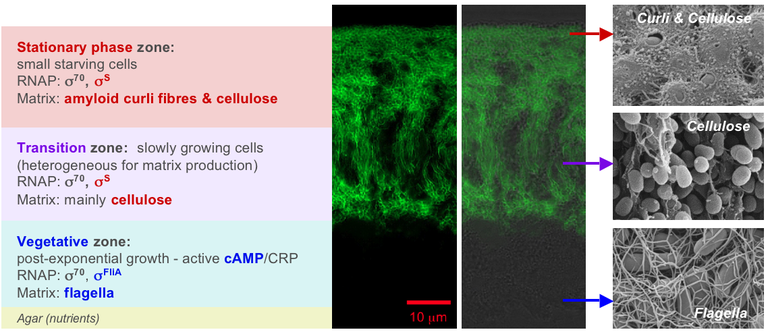.

The RpoS-dependent general stress response & biofilm formation of E. coli
Depending on the nutrient supply, bacteria can occur in very different physiological states: they either grow and divide or they enter into stationary phase, where remaining resources are used for maintenance and developing a pronounced multiple stress resistance. Stationary phase physiology of E. coli and other gamma-proteobacteria is mainly determined by RpoS (σs), an alternative sigma subunit of RNA polymerase (RNAP). RpoS, which controls >500 genes in E. coli, is itself regulated at the levels of transcription, translation and proteolysis, with this complex regulatory network acting as a signal integration machinery for a plethora of diverse stress signals. The temporal succession of growth and entry into stationary phase in a liquid planktonic culture translates into a spatial pattern in a macrocolony biofilm – growing flagellated cells are found in the bottom layer and outer colony edges, i.e. close to the nutrient-providing agar, whereas starving, matrix-encased and multiple stress resistant cells populate the upper layer. RpoS is in fact essential for matrix production, since it activates the expression of the transcription factor MlrA, which – together with RpoS-RNAP and a c-di-GMP signaling module (PdeR, DgcM) – activates the expression of CsgD, a biofilm regulator that directly activates the curli genes and indirectly controls cellulose biosynthesis. Moreover, about half of the GGDEF/EAL genes involved in c-di-GMP signaling are under RpoS control.
Current work in our group addresses the following questions:
- How does RpoS-RNAP – in cooperation with MlrA and YdaM and other DNA-binding factors – activate the csgD promoter?
- How does spatial regulation of RpoS accumulation and activity in a macrocolony biofilm work? Which signals are relevant for RpoS induction and how do the different levels of control of RpoS contribute?
Serra, D.O., and R. Hengge (2014) Stress responses go three-dimensional - the spatial order of physiological differentiation in bacterial macrocolony biofilms. Environ. Microbiol. 16, 1455-1471.
Pesavento, C., and R. Hengge (2012) The global repressor FliZ antagonizes gene expression by sigma-S–containing RNA polymerase due to overlapping DNA binding specificity. Nucl. Acids Res. 40, 4783-4793.
Hengge, R. (2011) The general stress response in Gram-negative bacteria. In: Bacterial Stress Responses (eds. G. Storz and R. Hengge), ASM Press, Washington, D.C., pp. 251-289.
Hengge, R. (2009) Proteolysis of sigma-S (RpoS) and the general stress response in Escherichia coli. Res. Microbiol. 160, 667-676.
Pesavento, C., G. Becker, N. Sommerfeldt, A. Possling, N. Tschowri, A. Mehlis, and R. Hengge (2008) Inverse regulatory coordination of motility and curli-mediated adhesion of E.coli. Genes Dev. 22, 2434-2446.
